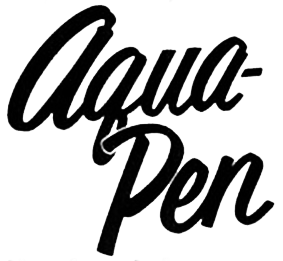Universal / Empex Aqua Pen c. 1959-1967
by Jim Mamoulides, January 21, 2010, updated January 13, 2018 and June 29, 2023
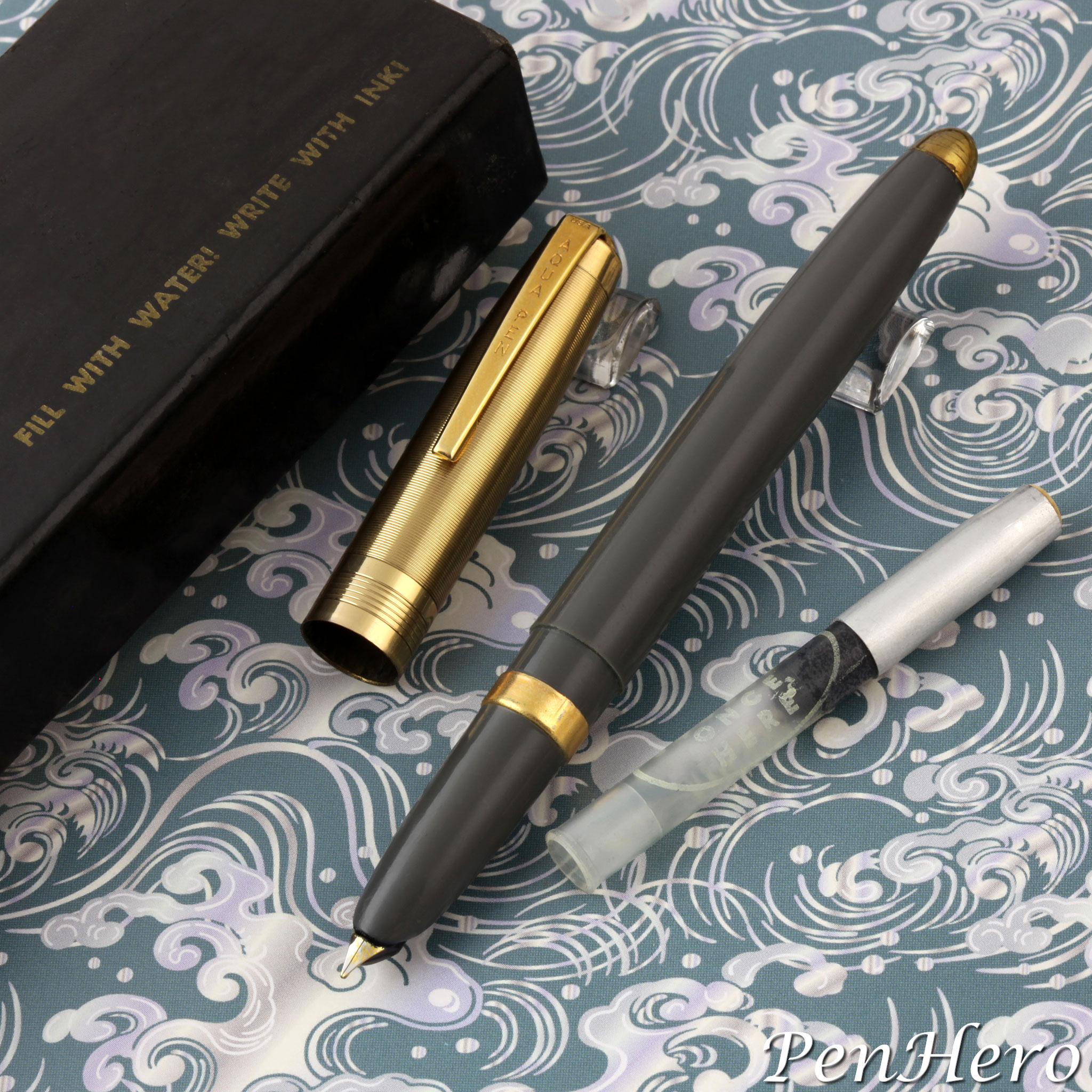 Aqua Pen fountain pen in gray c. 1961-1967
Aqua Pen fountain pen in gray c. 1961-1967
Let’s Make Some Ink!
The Aqua Pen, the patented brainchild of Max Goldman and Alex Goldman of the Universal Fountain Pen & Pencil Company, Inc., is actually an ink making pen idea that goes back to the Trench Pens of World War I. Trench pens were eyedropper pens that stored dry ink pellets in a small compartment in the end of the barrel. When the user ran out of ink, they would drop one or two pellets in the barrel, fill it with water and give it a few shakes to make ink. The idea was revisited several times since, with the Waterpen in the 1930s and the Grieshaber Graph-O-Matic Inkmaker pen in the 1940s, both using dry “ink batteries” or “ink sticks” that were put in the ink chamber and made ink when the pen was filled with water.
The Aqua Pen modernizes these ideas by combining them with a modern cartridge pen concept. The first patent applied for on December 10, 1957 by Alex Goldman and Max Goldman essentially has an ink tablet inserted inside the ink sac of a lever-fill fountain pen and was granted on September 15, 1959 as U. S. patent number 2,904,008. Their March 31, 1959 patent, number 2,879,744, applied for on January 22, 1958, is for a "Sponge activated water filled ink cartridge pen." In it the inventors describe three versions of a new dry ink making pen concept using a sponge laced with ink powder. In each case activating the dry ink sponge and making ink was accomplished by filling the pen. The first design was a lever fill fountain pen with a dry ink sponge cartridge inside of the ink sac:
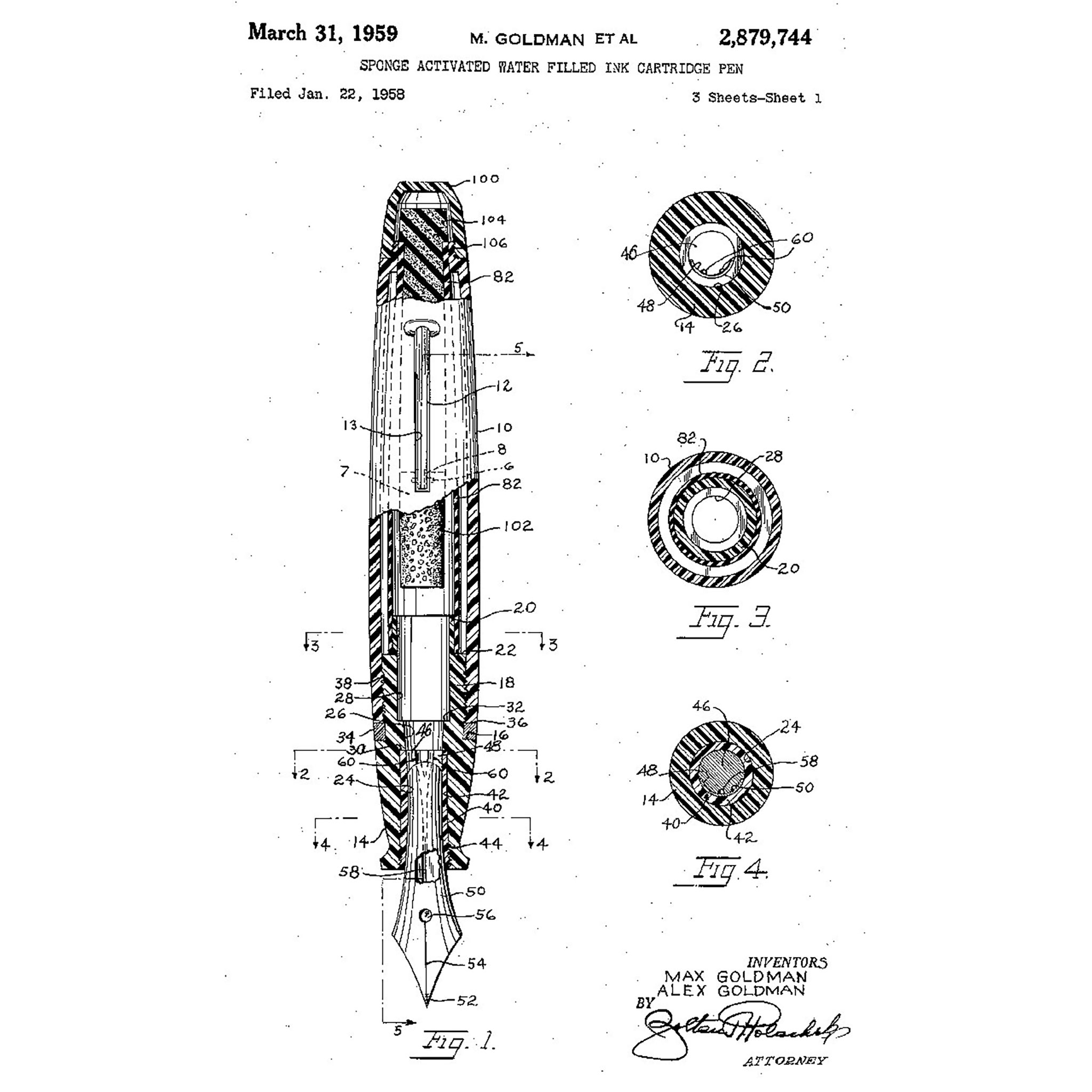 1959 Aqua Pen patent showing lever fill concept
1959 Aqua Pen patent showing lever fill concept
The second design was a leverless pen that would operate by squeezing a pliable end cap to compress and fill the dry ink sponge inside the ink sac. The patent even offers that the end cap (item 110 in the drawing) could be transparent in order for the user to see inside. Note figures 9-12 in the following image:
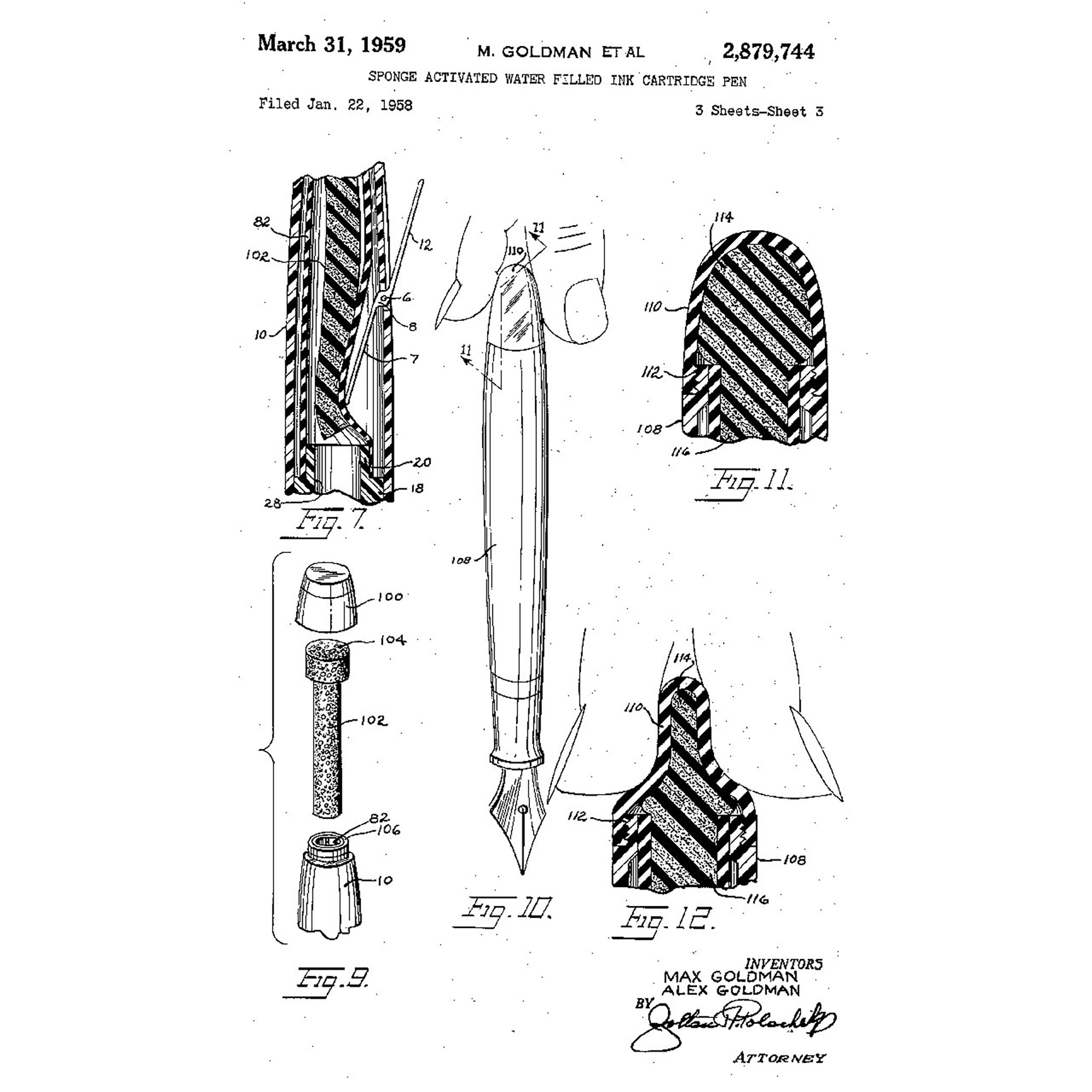 1959 Aqua Pen patent showing pliable end cap fill concept
1959 Aqua Pen patent showing pliable end cap fill concept
The third design is similar to the first but leaves a space which serves as a reservoir for ink with a gasket between the bottom end of the cap and the top of the barrel to seal the ink in the pen. See figure 13 below:
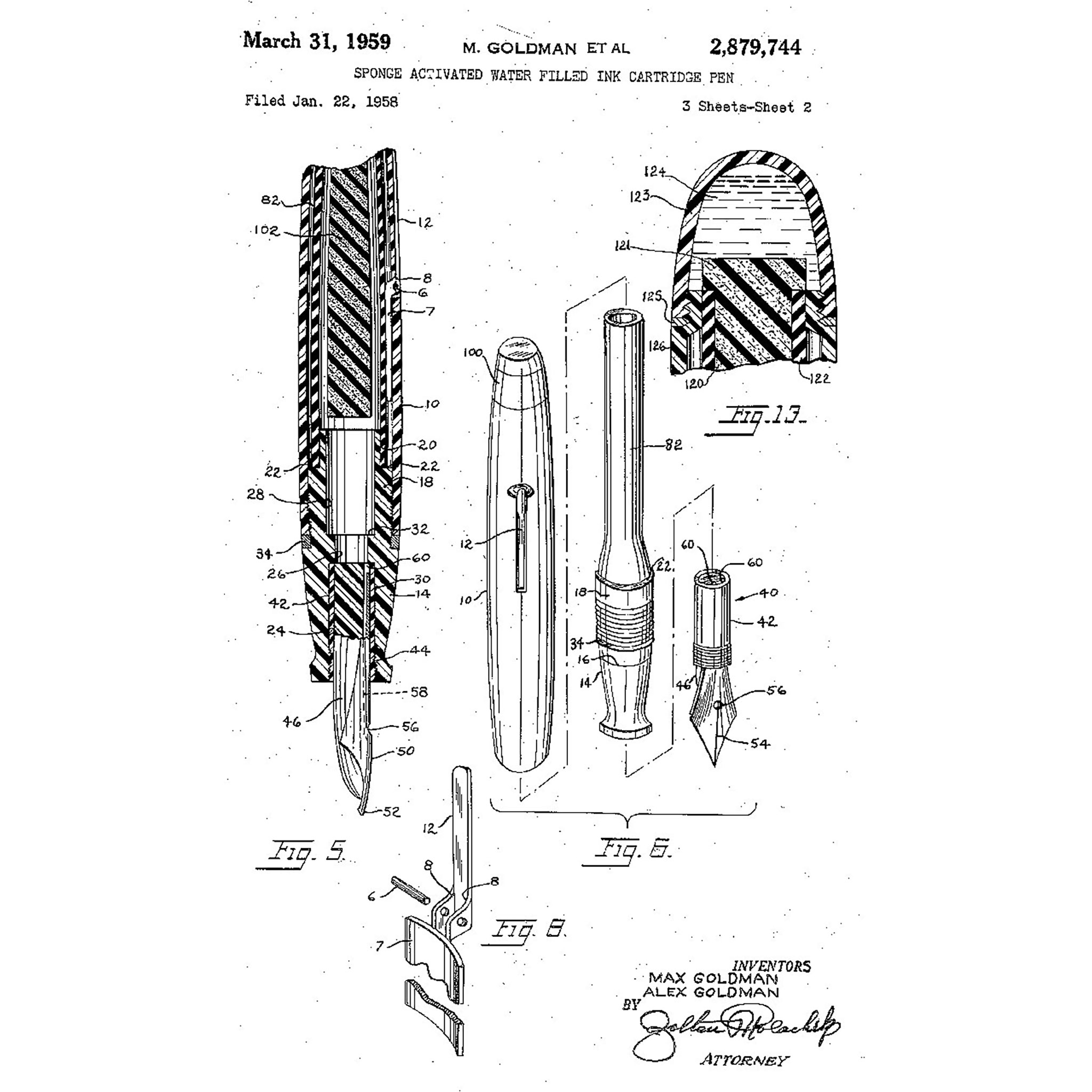 1959 Aqua Pen patent showing final design concept
1959 Aqua Pen patent showing final design concept
What became the Aqua Pen is a variation of the second design. The ink sponge is now in an "Ink Activator Cartridge" made from the same pliable plastics as used in squeeze bottles. The unit is now removable and replaceable, instead of depending on an externally operated mechanism. The Ink Activator Cartridges were initially advertised as good for 10 refills in 1959 but by 1963 were being advertised as good for 15 or as many as 25 refills in separate advertisements that year. That would make them a much better value than standard ink cartridges sold at the time.
The Aqua Pen replaceable Ink Activator Cartridge is a clear cylindrical unit similar to, though much longer than, a Sheaffer Skrip ink cartridge. The closed metal end contains the ink sponge, and it can be seen through the clear cartridge. The cartridge is inserted onto the back of the feed, just like a modern cartridge pen, the nib is then dipped in clear water, and the cartridge is filled by squeezing it, mixing the water with the dry ink. The cartridge has SQUEEZE ONCE HERE TO FILL and the patent number, 2,879,744 printed on it.
There is speculation that the Aqua Pen may have been inspired by the Italian LUS Atomica Magica, introduced at the Milan Trade Fair in 1959, a pen that used ink pellets and a special plunger type removable converter to mix them with water drawn into the pen. The LUS Atomica Magica was marketed as, "You fill it with water, it writes with ink!" and the LUS pen could also be used with regular ink cartridges. Sounds very familiar, but there are some key differences and patent dates that may dispel that idea. The patent for the Aqua pen is for a "Sponge activated water filled ink cartridge pen" and was applied for on January 22, 1958 and awarded March 31, 1959. The LUS Atomica Magica has a removable syringe filler that the user can drop pellet ink tablets into and make ink, or simply fill from a bottle, or remove it and use ink cartridges. These are two very different design concepts. I believe that they were arrived at independently.
Just How Universal Is The Aqua Pen?
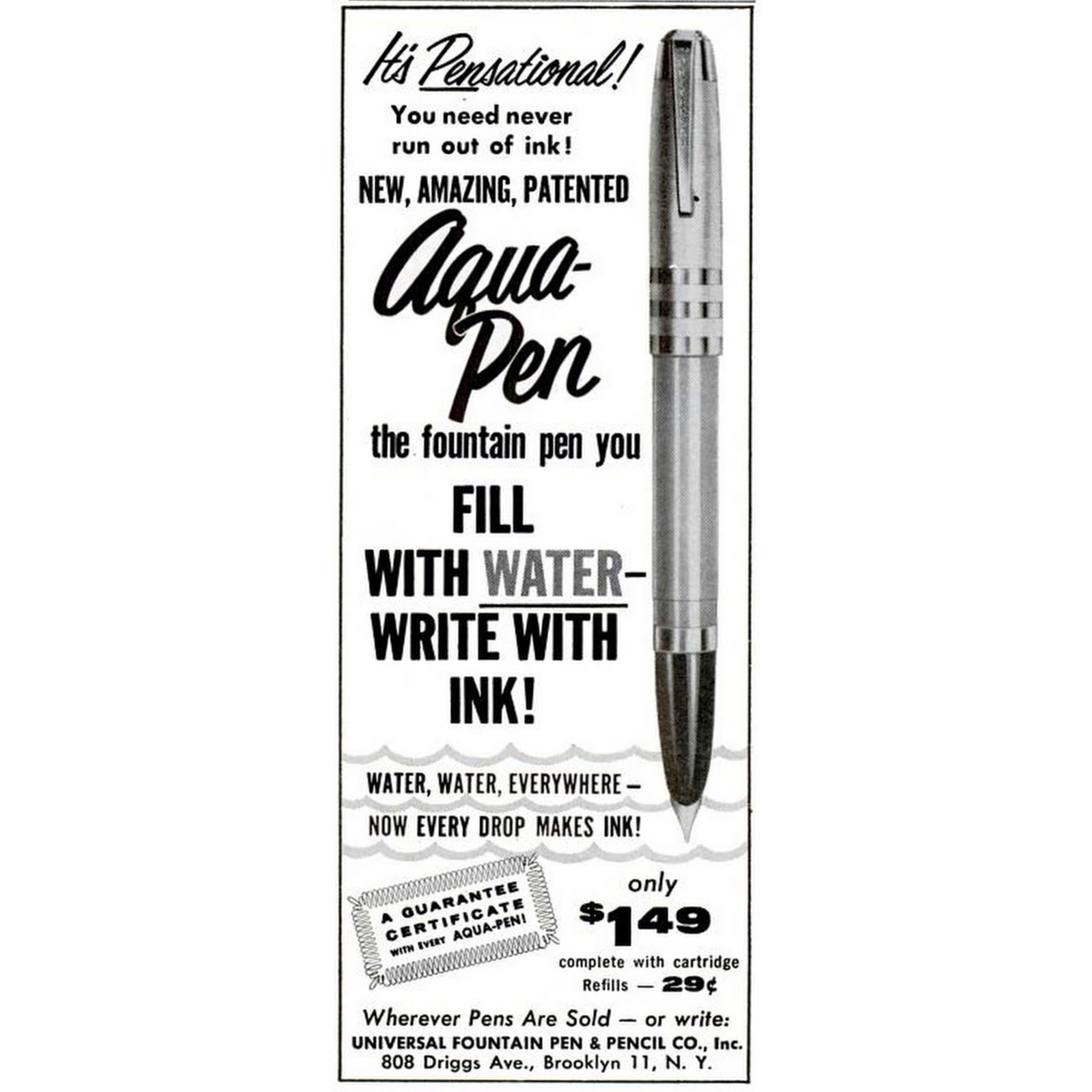 Universal Aqua Pen advertisement, LIFE Magazine, August 31, 1959
Universal Aqua Pen advertisement, LIFE Magazine, August 31, 1959
The earliest Aqua Pen advertisements are from 1959 and use the slogan, “Fill with water – Write with ink!” The earliest pens have a gold plated pull off metal cap, an injection molded plastic barrel, a semi-hooded gold plated stainless steel nib, and UNIVERSAL stamped on the clip. They sold for $1.49 with one cartridge and replacement cartridges were 29 cents. Each ink cartridge was said to be reusable for up to ten fillings. The company name, Universal Pen & Pencil Company, Inc., and address, 808 Driggs Avenue, Brooklyn, NY, appear in these early advertisements.
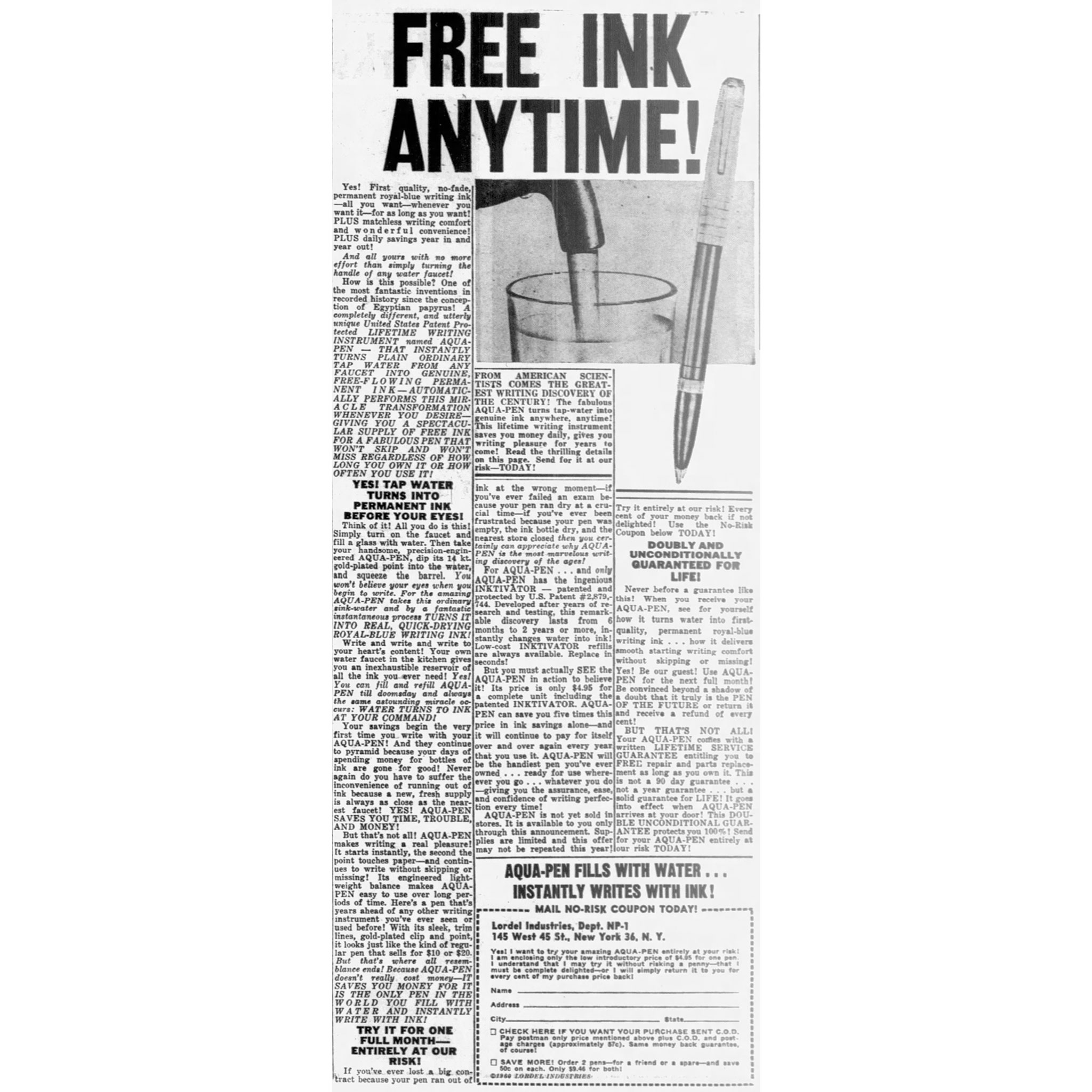 Aqua Pen advertisement, New York Daily News, September 7, 1960
Aqua Pen advertisement, New York Daily News, September 7, 1960
Then things get quiet. Aqua Pen advertisements mostly disappear in 1960. I found one lone, large, very detailed three column advertisement in the New York Daily News, September 7, 1960 by Lordel Industries of 145 West 45 Street, New York, NY. The ad, filled with exclamation points and all caps marketing statements does bring out some interesting news since the 1959 launch. The pen now sells for $4.95 with one “Inktivator” royal blue ink cartridge. Quite the price increase from $1.49 a year earlier. The ad also says Aqua Pen is “not yet sold in stores” and “supplies are limited.” What happened? My guess is there was some retrenching after launch in 1959. The pen shown looks like the 1959 Universal Aqua Pen, but the name Universal is nowhere in the ad nor shown on the pen’s clip.
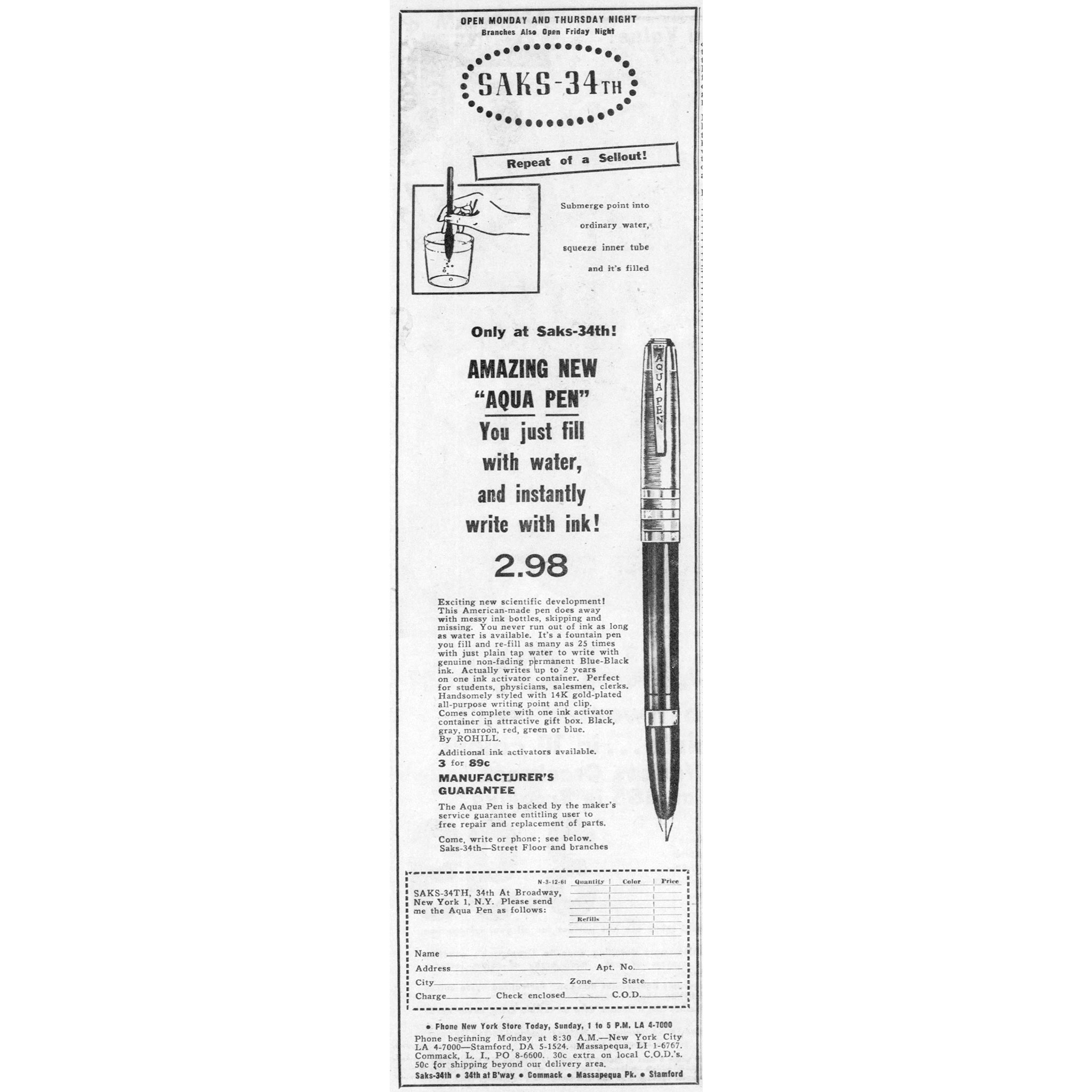 Aqua Pen advertisement, New York Daily News, March 12, 1961
Aqua Pen advertisement, New York Daily News, March 12, 1961
Starting in January, 1961 numerous Aqua Pen retailer advertisements begin to appear. The pens look the same as the 1959 Universal Aqua Pens, but now they have AQUA PEN stamped on the clip and are priced at $2.98 with one blue-black “ink activator” and available in black, gray, maroon, red, green or blue. Additional ink activators are three for 89 cents. The Universal Fountain Pen & Pencil Company nor Lordel Industries are ever mentioned again in any later ads I’ve reviewed. Other than made in the U. S. A., the manufacturer’s name is not stated until March 12, 1961 in a retailer advertisement in the New York Daily News, with the cryptic “By ROHILL" tag line at the end of the ad copy. Who is Rohill? The Universal Fountain Pen & Pencil Company was certainly still in business, advertising for distributors for Aqua Pens in the early 1960s and retailer ads can be seen for Universal ballpoint pen and pencil sets as late as 1967.
The Other Guys
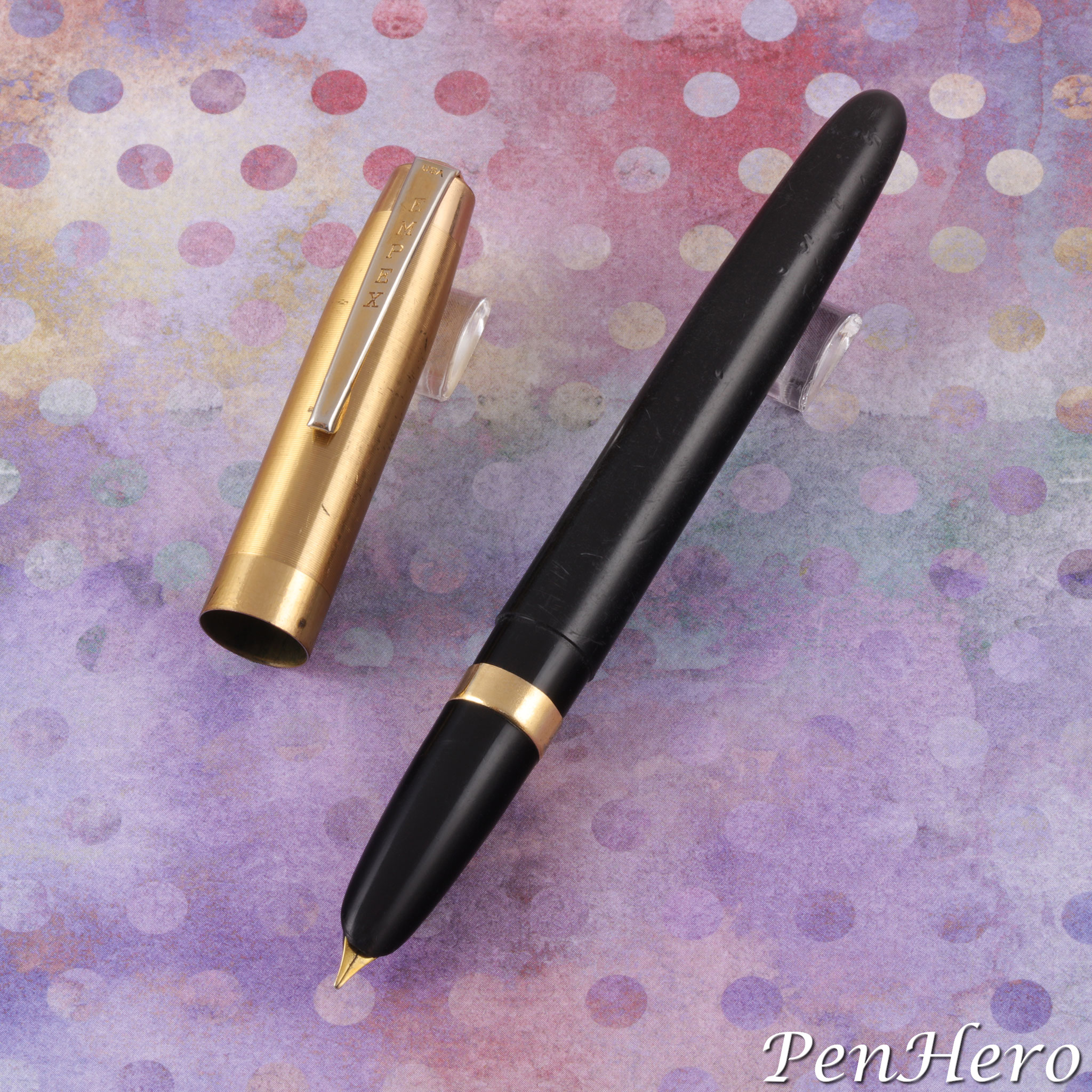 Empex branded black fountain pen, it came with a squeeze filler unit c. 1963
Empex branded black fountain pen, it came with a squeeze filler unit c. 1963
Having seen Lordel Industries in 1960 and now the Rohill Company of 1133 Broadway, New York, NY in 1961, let’s not leave out Empex, a name on many Aqua Pen boxes and on several examples of Aqua Pens I have seen. The name makes an appearance in a just a few ads I found from 1961 to 1963, including the one below that appeared in the April 1963 Boy’s Life, offering the Aqua Pen for $3.50. Aqua Pen instructions may have other company names on them, such as R. E. Kindel & Co. of Cincinnati, Ohio, for example. It's possible they were marketed from 1961 to 1963 as Empex Aqua Pens. The Rohill Company was actively seeking distributorships for the pen in 1962 and 1963 as well as Ultra Enterprises, Inc., of 527 Lexington Ave., New York in 1962 and 1966. Rohill is named in retailer ads through at least 1965. Who are all these other companies?
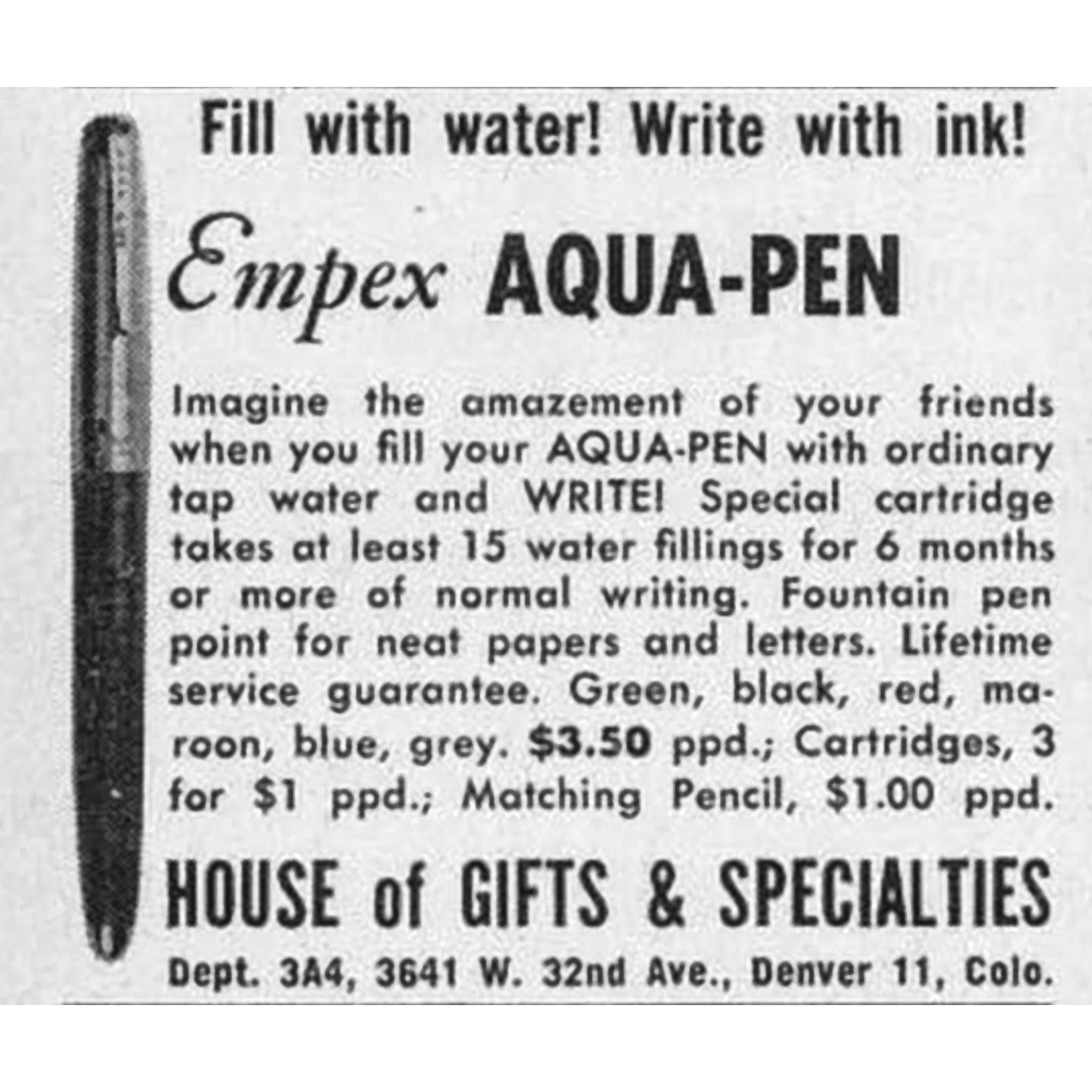 Empex Aqua Pen advertisement, Boys Life, April, 1963
Empex Aqua Pen advertisement, Boys Life, April, 1963
Since the Universal Fountain Pen & Pencil Company was still in business, I will speculate, based on advertisements seeking distributors and local people to service retailers with stock levels, that Rohill in particular may be a “Doing Business As” name or entity for Universal and these other companies were national or regional distributors that serviced local retailers. I don’t have any direct Universal company information, but the pattern of advertisements appears to tell that story. It could be that a condition of being a distributor would be to take stock and service retailers and end customers, similar to manufacturer distributors today. The advantage to Universal would be cash flow: getting wholesale cash from their distributors for quantity stock orders, and then not having to deal with retailers and small orders.
Empex appears to be either a brand name Universal tried out for the Aqua Pen or it could be branding for a specific distributor. The name Empex appears a ony few times in retailer ads from 1961 to 1963. The majority simply say Aqua Pen. I have not seen an address for Empex in any advertisements or documents. The Empex clip pens and Aqua Pens in Empex branded boxes I have seen all have Rohill’s or a distributor’s name and address on the paperwork with the pen. All this is probably confusing to later collectors, but customers at the time simply wanted to know who to go to for after sale support. They’re all Aqua Pens, after all.
Identification guide and features: Aqua Pen
 Aqua Pen blue fountain pen, c. 1961-1967
Aqua Pen blue fountain pen, c. 1961-1967
Aqua Pens are all basically the same pen with cosmetic variations in terms of clip stamping and cap design. The earliest Aqua Pens have UNIVERSAL stamped on the top mounted washer type clip and a metal cap with a three band design, as shown in the 1959 advertisement, and a gold plated metal end cap on the barrel. This version was possibly made from 1959 through 1960. Examples of the second version I have seen have EMPEX stamped on the clip, a single wide “cap band” and no gold plated metal end cap on the barrel. Production dates are unknown. The third and most commonly found version has AQUA PEN stamped on the clip and the metal cap has a tight ribbed design with a wide cap band with a ribbed section, and a gold plated metal end cap on the barrel. Primary information on the details and colors of the earlier two versions are limited, so the following information applies only to the third version, the Aqua Pen. After reviewing every Aqua Pen ad I could find there is no mention about a matching pencil and I have never seen one.
- Gold plated metal cap
- AQUA PEN stamped on clip face
- Cap pulls off
- Injection molded plastic barrel with gold plated round end cap
- Barrel colors included black, gray, maroon, red, green or blue
- Nib section will be black or barrel color
- Gold plated trim
- Nib grades unknown, but advertising and sample pens suggest one grade, probably fine/medium
- Nib has folded tines instead of tipping material
- Ink cartridge filler makes blue-black ink where the dry ink is activated by squeezing water into the cartridge through the nib
- 5 1/8 inches long capped
- Lifetime service guarantee
- Sold in paperboard boxes
- Fountain pen sold for $2.98 and later $3.50
- Replacement ink activator cartridges were 35 cents, or later 3 for $1.00
Performance
I like pens with interesting filling systems. Whenever I am out pen hunting, I will scoop up anything that has something other than a lever or cartridge fill system. It doesn't matter that many of these finds fall into the cheapie category. If it's off the beaten path, I'll snag it.
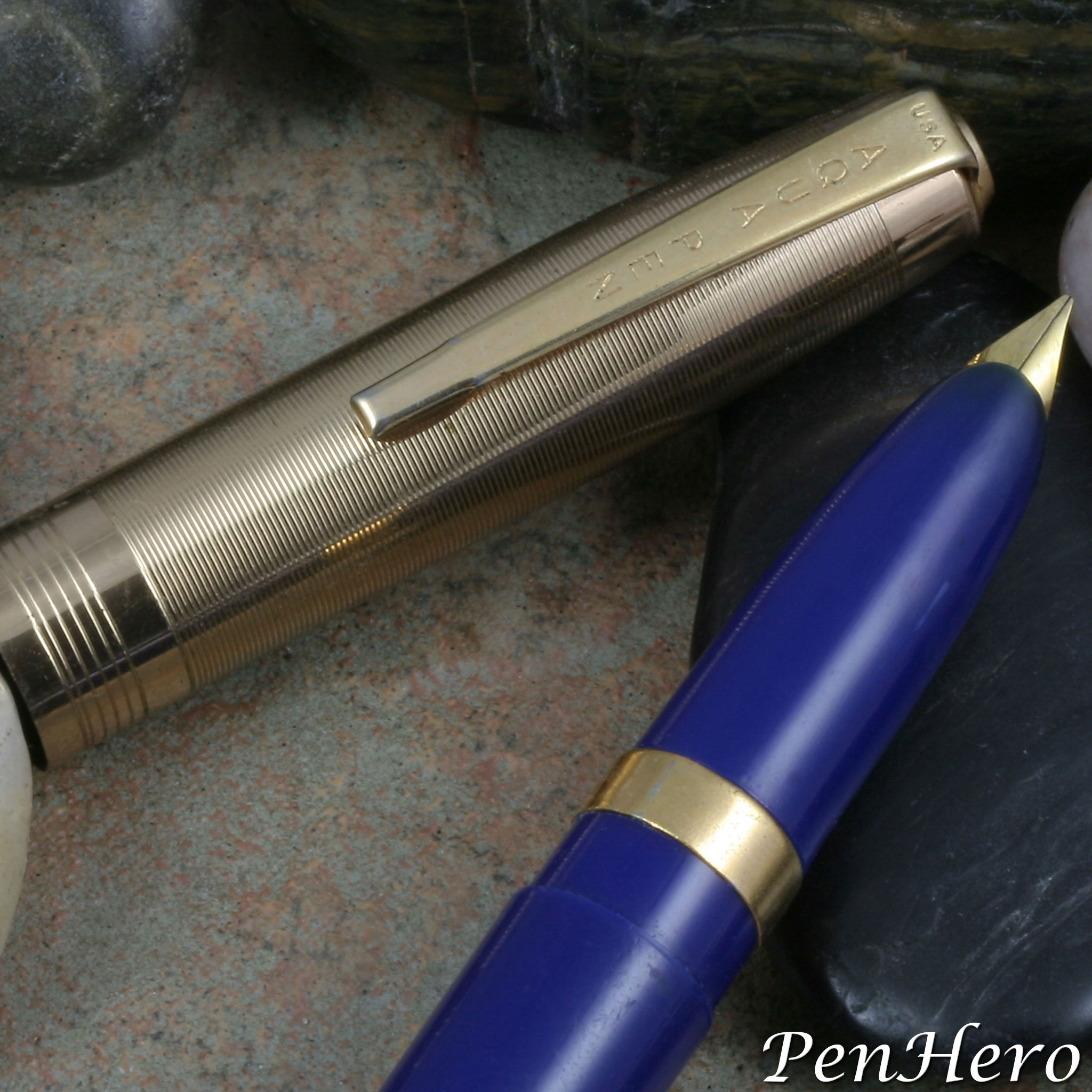 Aqua Pen blue fountain pen, cap and nib detail, c. 1961-1967
Aqua Pen blue fountain pen, cap and nib detail, c. 1961-1967
I picked the blue Aqua Pen to test. I found it in a cigar box in the upstairs of an antique shop in Maine. The box was full of cheapies, including a slew of Wearever Pennants. When I first noticed this one, the cheaply plated gold cap with radial lines and soft injection molded plastic barrel made me think it was a Sheaffer Fineline, and I already have plenty of them and I hate their cheap plating that goes foxy weird at the drop of a hat. I started to set it down but noticed the gold button on the end of the barrel, so I gave it a closer look. The clip said, "AQUA PEN." I pulled the cap off and saw a cheap plated semi hooded nib. Unscrewing the barrel revealed only a nipple on the end of the section. Nothing was inside. I almost left it there thinking it was a cheap cartridge pen, but the name bugged me. What the heck is an Aqua Pen? I decided to buy it.
The blue Aqua Pen stayed in the cheap pen cases I use for "to be repaired" pens for a couple of years before I looked at it again. I try to organize my pen collection by brand and type, as I send many of them off to be fixed, so I need to know which pens are up for the next round of trips to the pen spa. I pulled it out, looked it over carefully and decided to do a little research.
Since originally, I didn't have any of the amazing Ink Activator Cartridges, I slipped an ink sac over the section nipple and squeezed in some ready mixed ink I have that comes in convenient bottles.
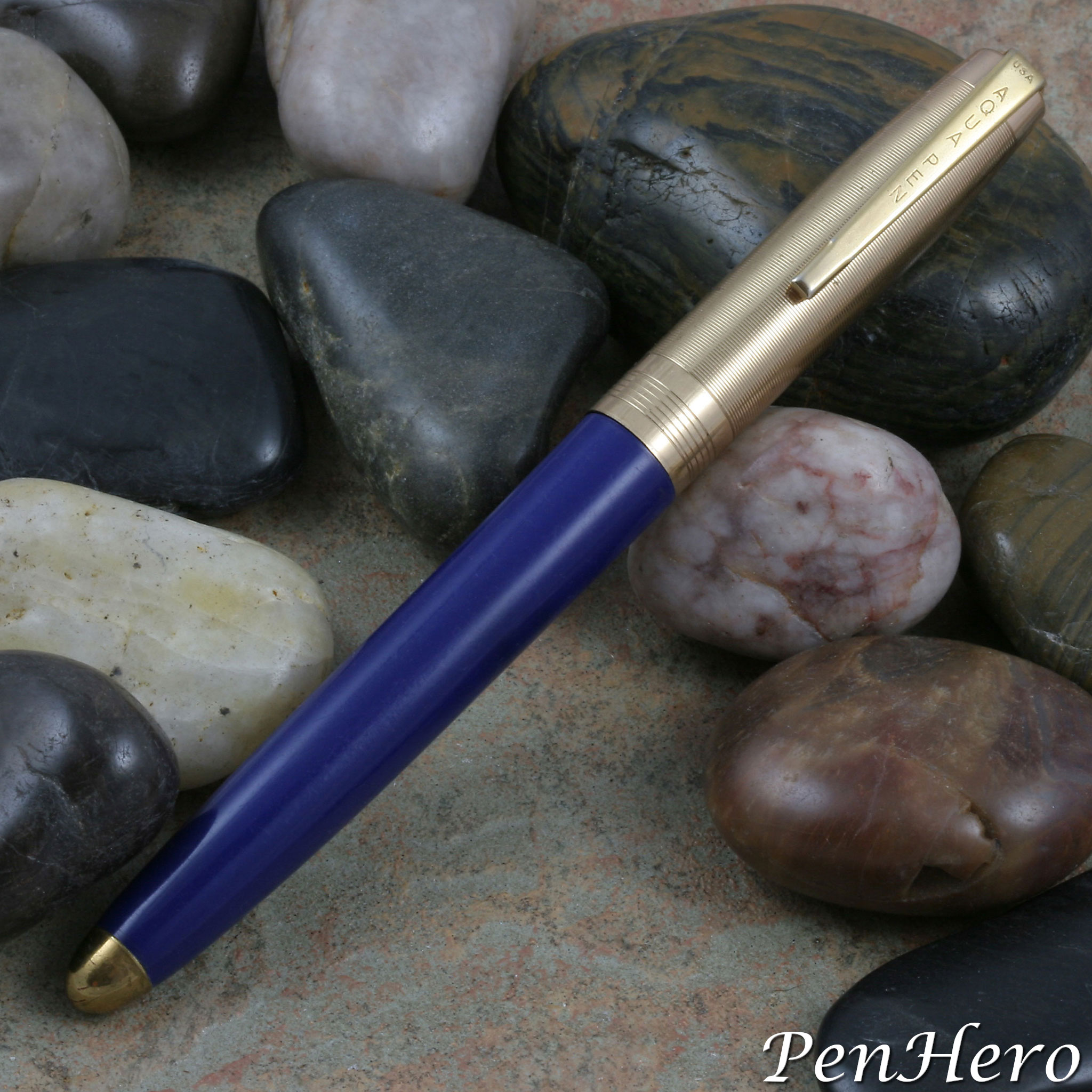 Aqua Pen blue fountain pen c. 1961-1967
Aqua Pen blue fountain pen c. 1961-1967
The Aqua Pen is small, slender and light by today's standards, the 0.5 ounce pen being 5 1/8 inches long with the cap on and 5 3/8 inches with the cap posted on the end of the barrel. The tiny steel nib and trim are 14 karat gold plated, and it’s a pretty cheap job, as the plating is worn all over the pen. The plastic barrel is prone to warping and some examples of these pens have banana bent barrels.
The surprise is the very nice and wet writing fine to medium nib that acts like a stub on paper, wide up and down and narrow left and right with smooth edges. This is actually a really nice writing pen. I have actually picked this one up and used it on many occasions after I put the sac on it. I'm not sure if I like it because it was such a surprisingly nice writing pen, or the fact that the nib turned out to be a stub, but I do like using it! I'm not sure how long it will last, as the nib has folded tines instead of tipping material, creating a tip bulge that does the same job, but will not be as hard or as long lasting.
Since the original review, I was able to obtain an Aqua Pen with actual Ink Activator Cartridges and decided to take it out for a test drive. The cartridge is pliable and works like any squeeze filler. Surprisingly it still had ink powder and made decent, though not deeply colored ink. As Consumer Reports found, the pen is a novelty and if I planned on using it regularly, I would put an ink sac back on it and use it as a squeeze filler with modern ink. Beware that sometimes this method will cause ink blobbing as there is no breather tube. I wonder how many owners did that once their amazing Ink Activator Cartridges were used up?
Aqua Pens are a novelty item. They won’t cost much, but they don’t appear frequently for sale. A lot will still be in the box. The difficult ones to find will be the earliest Universal clip pens, followed by the Empex clip pens. I prefer the pens with matching color nib sections and barrels. They are not bad writers and I recommend either using an Ink Activator Cartridge as a converter or putting an ink sac on it and using it as a bulb filler.
References
Advertisement, Arizona Daily Star, January 10, 1961, page 9
Advertisement, Boys’ Life, April 1963, page 76
Advertisement, Honolulu Star-Bulletin, August 29, 1962, page 62
Advertisement, Life Magazine, August 31, 1959, Page 75
Advertisement, New York Daily News, October 18, 1937, page 5
Advertisement, New York Daily News, March 12, 1961, page 101
Advertisement, New York Daily News, September 7, 1960, page 9C
Advertisement, Popular Mechanics, March 1942, page 189
Advertisement, The Boston Globe, May 6, 1962, page A-87
Advertisement, The Cincinnati Enquirer, December 15, 1963, page 107
Advertisement, The Cumberland News, March 23, 1961, page 2
Advertisement, The Daily Utah Chronicle, February 21, 1964, page 8
Advertisement, The Des Moines Register, January 1, 1963, page 30
Advertisement, The Greensboro Record, December 21, 1966, page A12
Advertisement, The Syracuse Journal-Democrat, September 06 Sep 1962, page 5
Advertisement, The Terre Haute Tribune, April 17, 1959, page 8
Advertisement, The Times-Tribune, April 13, 1964, page 24
Advertisement, The Times Recorder, December 22, 1961, page 6
Advertisement, The York Dispatch, October 3, 1966, page 28
Advertisement, Twin City Sentinel, January 4, 1967, page 7
Advertisement, Winston-Salem Journal, February 28, 1965, page 23
Business Opportunities Advertisement, “Scientific Breakthrough” The Boston Globe, May 14, 1961, page 133
Consumer Bulletin Annual 1961-1962, Consumers' Research, Incorporated, 1961, page 188
“Gadgets Get More Versatile” by Elmer Roessner Johnson City Press, February 4, 1960, page 4
Kiplinger's Personal Finance, July, 1959, page 26
United States Patent 2,879,744 granted March 31, 1959
United States Patent 2,904,008 granted September 15, 1959
Interact
Comments on this article may be sent to the author, Jim Mamoulides


